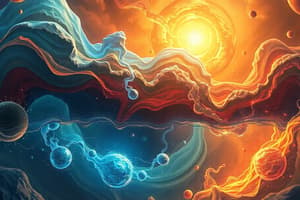Podcast
Questions and Answers
What is an exothermic reaction?
What is an exothermic reaction?
An exothermic reaction is a reaction that releases energy.
Explain why a reaction can occur only if the energy of the products is lower than the energy of the reactants.
Explain why a reaction can occur only if the energy of the products is lower than the energy of the reactants.
A reaction can occur only if the energy of the products is lower than the energy of the reactants because this energy difference drives the reaction forward.
Provide an example of an endothermic reaction.
Provide an example of an endothermic reaction.
An example of an endothermic reaction is ice melting in warm water.
What is a physical change?
What is a physical change?
Provide an example of a chemical change.
Provide an example of a chemical change.
What are the unique properties that define different types of matter?
What are the unique properties that define different types of matter?
Give an example of a double displacement (metathesis) reaction.
Give an example of a double displacement (metathesis) reaction.
Flashcards are hidden until you start studying
Study Notes
Uncovering the Secrets of Physical and Chemical Changes
When you drop an ice cube into a glass of hot tea, the ice melts, and the tea cools down. This transformation is an example of a physical change, where matter changes state but still consists of the same atoms and molecules. But what happens when you combine hydrogen and oxygen to produce water? That's a chemical change, where matter transforms into new substances with different properties.
Properties of Matter
All matter is made up of particles called atoms and molecules. Each type of matter has unique properties, such as color, hardness, and boiling point. Physical changes affect the state of matter (solid, liquid, or gas), but not its composition—the type of matter stays the same.
Types of Chemical Reactions
Chemical reactions can be classified as:
- Synthesis (combination)—Two or more substances come together to form a new substance. For example, when iron and oxygen combine to form rust.
- Decomposition—A single substance breaks down into two or more simpler substances. For example, when water breaks down into hydrogen and oxygen gas during electrolysis.
- Single displacement (replacement)—An atom from one substance switches places with an atom from another substance. For example, when zinc displaces copper from copper sulfate to form zinc sulfate and copper metal.
- Double displacement (metathesis)—Ions from two substances switch places within a balanced chemical equation. For example, when silver nitrate and potassium chloride form silver chloride and potassium nitrate.
Energy Changes in Reactions
Not all chemical reactions are spontaneous, meaning they don't happen on their own. A reaction can occur only if the energy of the products is lower than the energy of the reactants.
When a reaction releases energy, it is said to be exothermic. For example, a matchstick releasing heat as it burns. Conversely, an endothermic reaction absorbs energy. For example, ice melting in warm water.
Summary
Understanding physical and chemical changes is fundamental to the study of chemistry. By examining matter's properties and the types of chemical reactions, we can learn about the behavior of substances and the energy changes that occur during reactions. This understanding allows us to develop and predict the outcomes of various chemical processes, which is essential in fields like medicine, technology, and environmental science.
Studying That Suits You
Use AI to generate personalized quizzes and flashcards to suit your learning preferences.




